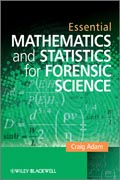
Essential Mathematics and Statistics for Forensic Science is an accessible, student-friendly introduction to the wide range of mathematical and statisticaltools needed by the forensic scientist in the analysis, interpretation and presentation of experimental measurements. From a basis of high school mathematics, it develops essential quantitative analysis techniques within the context of a broad range of forensic problems and contexts. The focus of the material is very much on the need to ensure that forensic measurements and calculationsare properly and accurately carried out then communicated reliably to others.Topics such as units, understanding uncertainties, basic chemical calculations and the evaluation of formulae are clearly prominent. These are illustrated using examples from molar and dilution calculations to more specifically forensic contexts such as body cooling after death and the dependence of fly egg development on temperature. Trigonometry is especially important in forensic science through its key function in evaluating bloodstain pattern evidence as well as in ballistics. Trigonometric calculations enable the trajectories of blood droplets or bullets to be determined from measurements taken at the crime scene. The quantitative analysis of drugs in solution or spiked drinks are examples where a good understanding is needed of graphical analysis and calibrationmethods applied to spectroscopic or chromatographic data. This text shows howthe reader can use computer spreadsheets to carry out many aspects of data analysis and to present the results in a professional graphical form Often forensic analysis aims to compare questioned and reference materials; for example, refractive indexes of glass fragments or microscopic measurement of hair diameters. An appropriate quantitative comparison needs statistical tools and, because of the increasing importance of such methods to forensic science, the topics of probability and statistics are fully covered within this book. Core statistical topics include applications of frequency histograms and probability distributions and how they relate to the mean and standard deviation; the normaldistribution, t-distribution and the application of the students t-test to data; the chi-squared test and the association of variables. Once again the application of spreadsheets, this time to the evaluation of statistical problems, is encouraged. In addition, forensic applications also make use of Bayesian statistics in assessing the significance of evidence; for example, finding a rare blood group, or a paint chip from an uncommon car at a crime scene means such evidence may carry greater weight than if the materials were commonplace. The application of Bayes Rule to generate a likelihood ratio for particular evidence types is fully explained and developed through a series of forensic examples in this book. The means by which such calculations may lead to verbal equivalence by the expert witness will be explored. Its broad scope, yet forensically focused coverage, make this accessible book an essential text for studentsembarking on any degree course in forensic science or forensic analysis, as well as an invaluable reference for masters students and forensic professionals.Craig Adam has over twenty years experience in teaching mathematics within the context of science at degree level. Initially this was within the physics discipline, but more recently he has developed and taught courses in mathematicsand statistics for students in forensic science. As head of natural sciences at Staffordshire University in 1998, he led the initial development of forensic science degrees at that institution. Once at Keele University he worked within physics before committing himself principally to forensic science from 2004. His current research interests are focused on the use of chemometrics in theinterpretation and evaluation of data from the analysis of forensic materials, particularly those acquired from spectroscopy. His teaching expertise areas within forensic science, apart from mathematics and statistics, include blood dynamics and pattern analysis, enhancement of marks and impressions, all aspects of document analysis, trace evidence analysis and evidence evaluation.
- ISBN: 978-0-470-74252-5
- Editorial: John Wiley & Sons
- Encuadernacion: Cartoné
- Páginas: 368
- Fecha Publicación: 09/04/2010
- Nº Volúmenes: 1
- Idioma: Inglés
